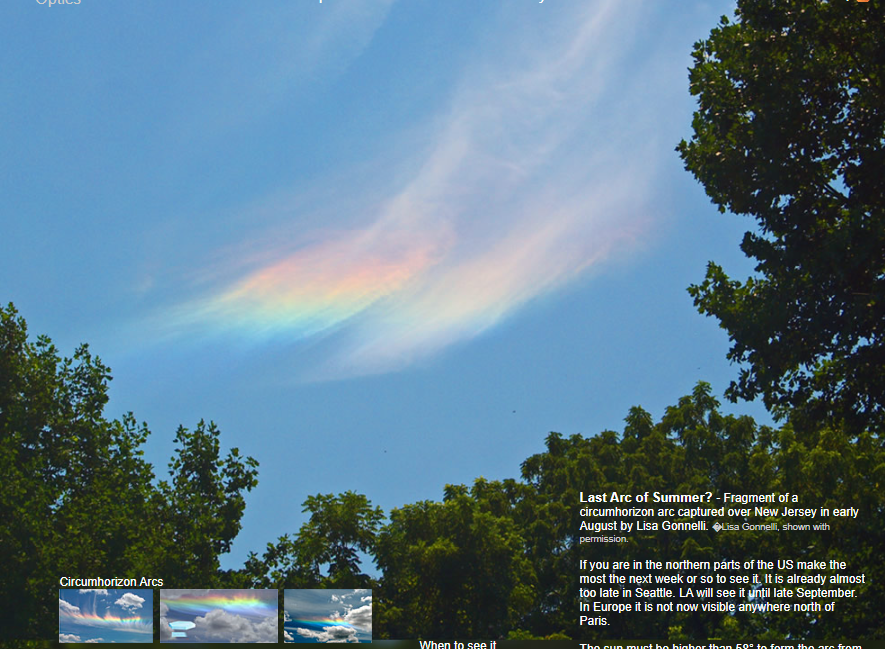Last Arc of Summer?
Last Arc of Summer: A Rare Atmospheric Phenomenon
Have you ever looked up at the sky on a clear summer day and noticed a stunning arc of colors? This mesmerizing optical phenomenon, known as the circumhorizon arc, is a sight to behold. While it may be relatively common in certain parts of the United States during the summer months, it remains a rarity in many other regions, including Europe. In this article, we will delve deeper into the last arc of summer, exploring its formation, visibility, and where and when you can catch a glimpse of this ethereal spectacle.
The Formation of the Circumhorizon Arc
The circumhorizon arc owes its existence to plate-shaped ice crystals present in high cirrus clouds. To witness this magnificent display, the sun must be at an altitude higher than 58°. When sunlight passes through these ice crystals, it undergoes a process called refraction. This refraction causes the light to separate into its component colors, forming a vivid band of hues that stretches across the sky.
The Rarity of the Circumhorizon Arc in Europe
While the circumhorizon arc may be a relatively common sight in many parts of the United States during the summer season, Europe is not as fortunate. In fact, this captivating phenomenon is rarely visible anywhere north of Paris. So, if you happen to find yourself in Europe during the summer months, make sure to keep an eye on the sky for any signs of this elusive spectacle.
The Ideal Conditions for Observing the Circumhorizon Arc
To catch a glimpse of the last arc of summer, you'll need clear skies and a high sun. In the United States, where summers often bring clear weather and abundant sunshine, sightings of the circumhorizon arc occur more frequently. On average, it may be seen around five or more times during the summer months in many parts of the country. However, as you venture further north, the chances of witnessing this phenomenon diminish.
The Window of Opportunity
If you reside in the northern parts of the United States, now is the time to seize the opportunity to witness the last arc of summer. As we approach the end of August, the chances of seeing this breathtaking display decrease. In Seattle, it is already becoming too late, while Los Angeles residents can expect to enjoy sightings until late September. So, if you haven't had the chance yet, make sure to keep an eye on the sky and savor this awe-inspiring natural wonder while you still can.
Capturing the Beauty
Many individuals are fortunate enough to capture photographs of the circumhorizon arc, freezing its ephemeral beauty in time. Photographers like Lisa Gonnelli, who captured a fragment of the arc over New Jersey in early August, allow us to marvel at this celestial phenomenon long after it fades from view. These stunning images serve as a reminder of the vast beauty that surrounds us and the remarkable wonders that can occur within our atmosphere.
The Magic of Atmospheric Optics
The circumhorizon arc is just one example of the many captivating optical phenomena that occur in our atmosphere. From rainbows and halos to sun pillars and iridescent clouds, these natural spectacles never fail to leave us in awe. By understanding the science behind these phenomena, we gain a deeper appreciation for the intricate workings of our atmosphere and the interplay between light and matter.
In conclusion, the last arc of summer, known as the circumhorizon arc, is a rare and captivating sight that graces the skies during the summer months. Formed by plate-shaped ice crystals in high cirrus clouds, this optical phenomenon showcases a vibrant band of colors stretching across the sky. While more common in certain parts of the United States, sightings are rare in Europe and become increasingly scarce as summer draws to a close. So, if you have the chance, make sure to look up and witness the ethereal beauty of the last arc of summer before it fades away until next year.

Last Arc of Summer? - Fragment of a circumhorizon arc captured over New Jersey in early August by Lisa Gonnelli. �Lisa Gonnelli, shown with permission.
If you are in the northern parts of the US make the most the next week or so to see it. It is already almost too late in Seattle. LA will see it until late September. In Europe it is not now visible anywhere north of Paris.
The sun must be higher than 58° to form the arc from plate shaped ice crystals in high cirrus cloud. In most of the US with high summer sun and clear skies it is a relatively common halo seen maybe five or more times each summer. Europe is not so favoured and there it is a rarity.
Note: this article has been automatically converted from the old site and may not appear as intended. You can find the original article here.
Reference Atmospheric Optics
If you use any of the definitions, information, or data presented on Atmospheric Optics, please copy the link or reference below to properly credit us as the reference source. Thank you!
-
<a href="https://atoptics.co.uk/blog/last-arc-of-summer/">Last Arc of Summer?</a>
-
"Last Arc of Summer?". Atmospheric Optics. Accessed on November 26, 2024. https://atoptics.co.uk/blog/last-arc-of-summer/.
-
"Last Arc of Summer?". Atmospheric Optics, https://atoptics.co.uk/blog/last-arc-of-summer/. Accessed 26 November, 2024
-
Last Arc of Summer?. Atmospheric Optics. Retrieved from https://atoptics.co.uk/blog/last-arc-of-summer/.